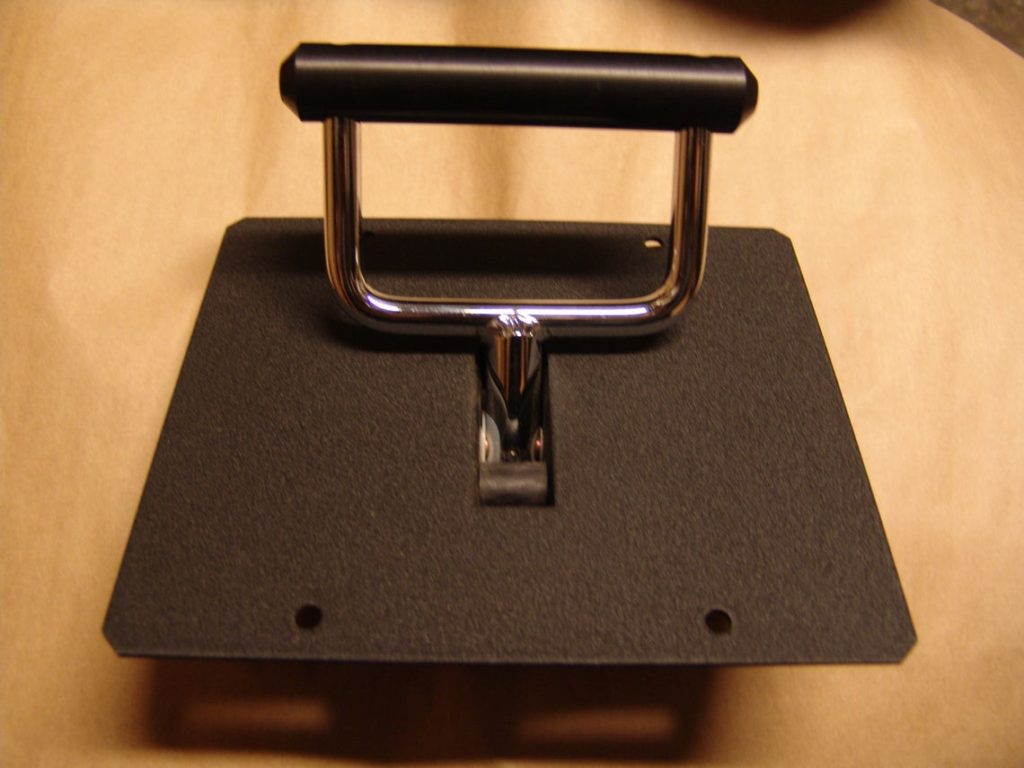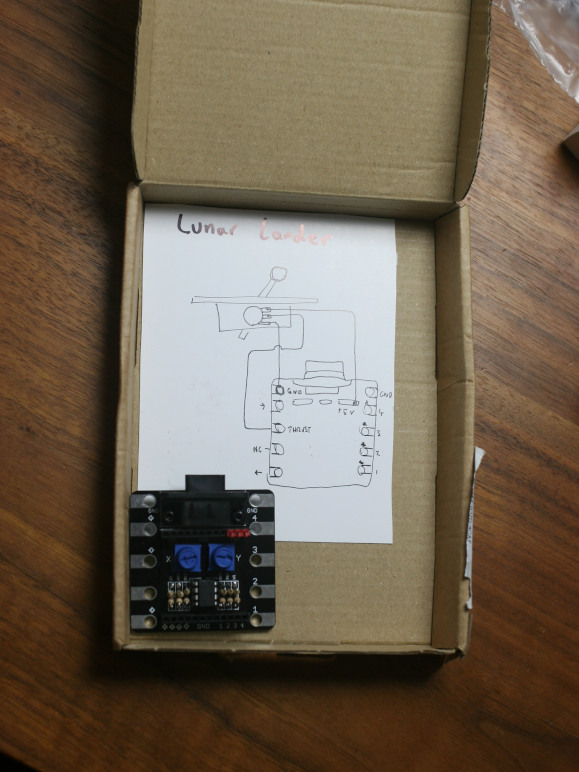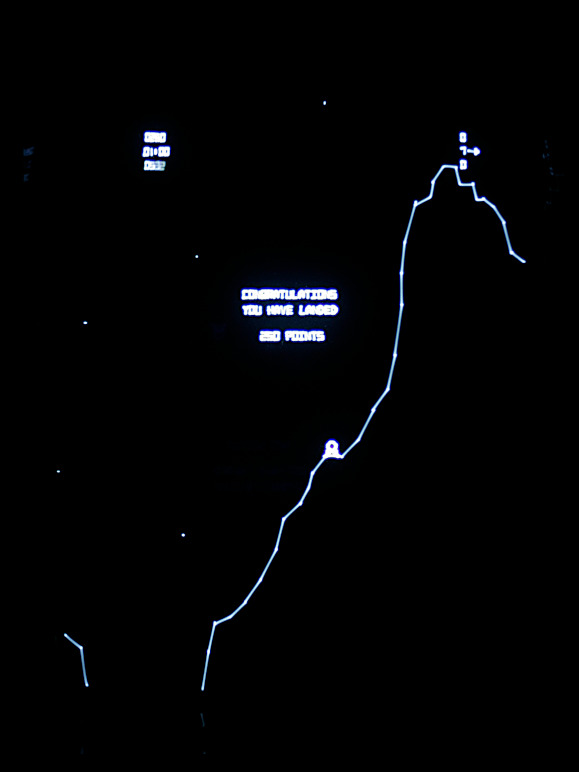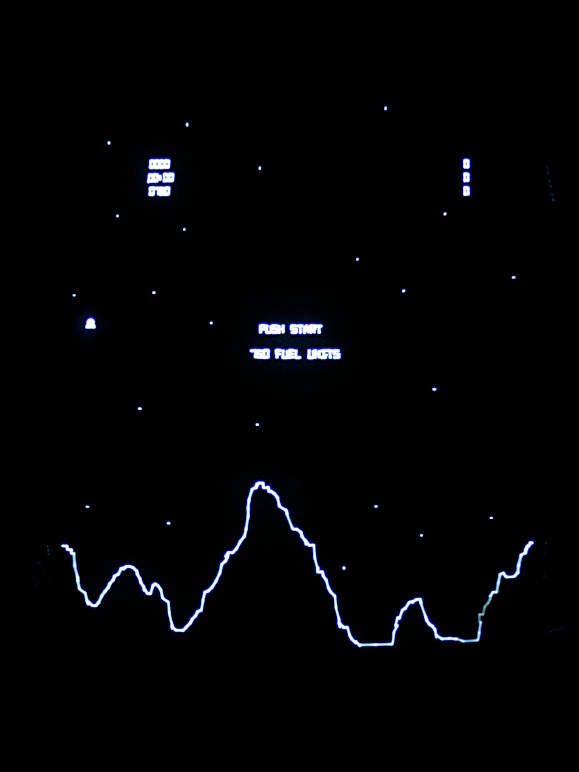VecFever documentation
Lunar Lander
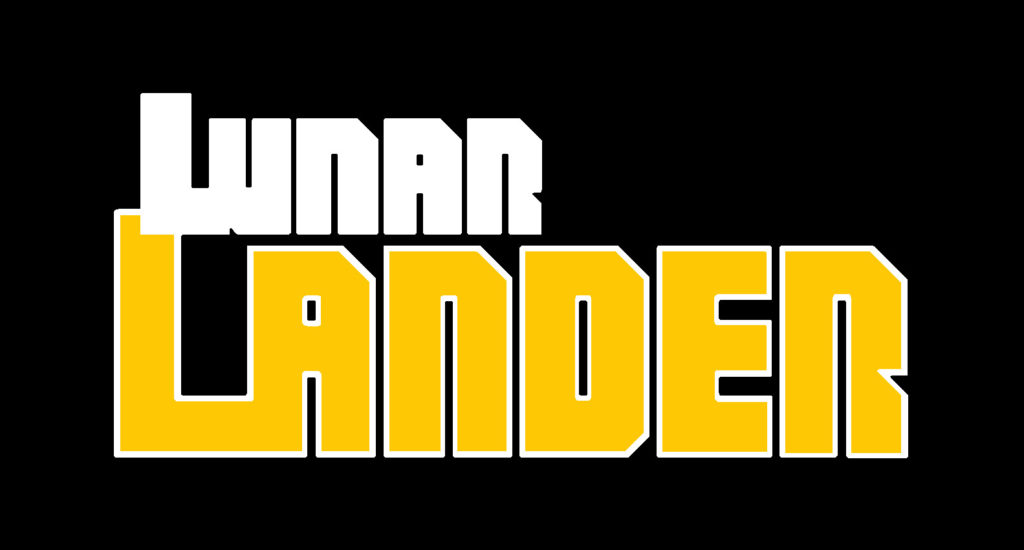
Atari, 1979
Lunar Lander occupies a special place as a vector game for me: it is besides Asteroids the only one I remember seeing as a child in the wild. And not being allowed to play it since it was ‘only for grown-ups’ – quite likely my parents saw just how fast I would spend (their) money on this game. But they had a point – this game is a bit unique in that it is more a simulation for people with an engineering streak or those with an interest in the enormously important NASA landings on the actual moon just a few years before.
In a way this is also a very late example of arcade games a lot older: their premise was to just entertain you for a given amount of time per credit and with Lunar Lander this works for me simply by imagining that I am really approaching the moon when playing the game: of course it is slow. Of course fuel is a problem. And if you are better you can play a bit longer, so the ‘newer’ skill carrot is there but scores are not all that important. Well, watch the movie ‘First Man’ if you do not know what this is about…
The game concept – a moon landing simulation on a vector display – was not even a new idea and Atari sw. engineers must have seen this before on a vector display and likely thought of it when Atari hw. engineers developed their vector hardware – the ‘d’igital ‘v’ector ‘g’enerator, DVG – basically a dedicated vector CPU build discretely with plenty of chips working in tandem and fed by a 6502 CPU. The lunar lander vector output is actually still quite challenging for this hardware which is why the refresh rate is not all that high on original hw – so the vector count quite high. Or in other words: it was a very good test case for the hardware – and the very next game running on this hw, Asteroids, basically is the perfect vector game and perfectly suited to it. In fact Lunar Lander hw is a superset of Asteroids – has a higher ROM size for example – and a majority of lunar lander pcbs I have seen available the past years were actually converted to Asteroids by operators back then.
So the game is a slow simulation – does not even have all that much sound: just noise, an explosion once you crash and a warning ‘beep’ once the fuel is low. The one thing the original cabinet does have is using a great control panel, typical for Atari frequently but here they went all out: it uses an impressive thruster assembly, think of it as a one-dimensional, analog joystick. Only massive and if you think that is not important to get into the mood, feeling that hunk of metal in your hands to precisely set the thrust of your lander, you do not get the game. It also uses inlayed images backlit by lamps in the control panel itself to give you that feeling of technology of the era (and at the same time output the selected mission).
So if you are running this on the Vectrex expecting an arcade game – fast and the assumption that it is about hiscores – you will be disappointed. In the past years reproductions of the Lunar Lander arcade cabinet’s thruster assembly have appeared and are either used for restorations of Lunar Landers or been incorporated in ‘multi’-panels for Asteroids to play Lunar Lander as it is mostly meant to be there, too, and Jim Watts actually hooked one up to the Vectrex to play it with this huge hunk of a thruster – and – as a really nice gesture sent me one of his adapters (and I own a retro-thruster now, too), so thank you Jim !
Other than the actual arcade history this is also where the ancestors of the current binary translation tools and the start of the abstraction library began, years ago, since I wanted (and did) go along the timeline the games/pcbs were developed and I have rewritten and/or improved upon the code parts many times whenever necessary or advisable.
Input
- Button 4: Abort (‘panic’)
- Button 3: Turn Left
- Button 2: Turn Right
- Button 1: Turn Left
- Joystick-Y, Analog: Thrust
Options
- Fuel: 450 / 600 / 750 / 900 / 1100 / 1300 / 1550 / 1800
- Graphics: Vectrex / Arcade
- Language: English / French / German / Spanish
- Mission: Training / Cadet / Prime / Command
- Terrain: Fast / Precise (drawing mode geared towards faster or better looking)
- Game Info: ” Welcome to Lunar Lander, the very first vector arcade game by Atari. The game idea far precedes Atari’s version: just a few months after the Eagle has landed a decade earlier in 1969 on the Sea of Tranquility the very first, text-only version programmed by Jim Storer was running on a PDP-8. For quite a few years it was purely a turn-based text game but a first graphics version had also already been written by Jack Burness in 1973 as a software demo for the DEC GT40 vector terminal. So it was no coincidence that Atari engineers turned to this game idea when deciding on what to try out on their newly developed vector hardware. Atari’s version came to a sudden halt production-wise only due to the reason that they developed a massive hit on the nearly same hardware platform during the same year of 1979: Asteroids. The very first Asteroids machines shipped even had Lunar Lander side-art, the rush to get them out the door was that pressing (and the cabinet style identical).. The original runs at 41Hz refresh so this time I decided to add two graphics modes: either everything in its original, flickering glory or a faster Vectrex version at 50Hz – the game also runs (a bit) faster then, too, since it is just too slow for me. The portrait mode was also straightforward: just convince Lunar Lander to display everything all the time here.. and let me take care of clipping and other technical details for the larger display. And shuffle the texts around, as usual. All in all I am very pleased with the result – I thought the Vectrex probably could not handle the terrain well enough precision-wise to be able to land.. “
Localization
//NAME="LLANDER"
//
GERMAN[] = {
{ 0, 0, 0},
{ 0, 0, 0},
{ 0, 0, 0},
{ 0, 0, 0},
{ 0, 0, 0},
{ 0, 0, "Treibstoff"},
{ 0, 0, "Grafik: Vectrex"},
{ 0, 0, "Grafik: Arcade"},
{ 0, 0, "Gelände: Schnell"},
{ 0, 0, "Gelände: Präzise"},
{ 0, 0, 0}
};
FRENCH[] = {
{ 0, 0, 0},
{ 0, 0, "Commandement Suprême"},
{ 0, 0, "Commandement Supérieur"},
{ 0, 0, "Commandement en Second"},
{ 0, 0, "Entraînement"},
{ 0, 0, 0},
{ 0, 0, "Graphismes: Vectrex"},
{ 0, 0, "Graphismes: Arcade"},
{ 0, 0, "Terrain: Rendu Standard"},
{ 0, 0, "Terrain: Rendu Amélioré"},
{ 0, 0, " Bienvenue dans Lunar Lander, le tout premier jeu d'arcade vectoriel d'Atari. Il faut savoir que l'idée du jeu est bien plus ancienne que la version d'Atari : dix ans plus tôt en 1969, et seulement quelques mois après l'alunissage de l'Aigle sur la Mer de la Tranquillité, la toute première version en mode texte, programmée par Jim Storer, fonctionnait déjà sur un PDP-8. Pendant plusieurs années, il ne s'est agit que d'un jeu basé sur du texte; mais une première version dotée de graphismes fut écrite par Jack Burness en 1973 en tant que démo logicielle pour le terminal vectoriel DEC GT40. Ce n'est donc pas un hasard si les ingénieurs d'Atari se sont tournés vers cette idée de jeu lorsqu'ils ont décidé de ce qu'ils allaient essayer sur leur nouveau matériel vectoriel. La version d'Atari a soudain cessé d'être produite pour la seule raison qu'ils ont développé un jeu à succès sur la même plate-forme matérielle au cours de cette même année 1979 : Asteroids. Les toutes premières machines d'Asteroids expédiées avaient même un décor à la \"Lunar Lander\", dans la mesure où ils étaient pressés de les mettre à disposition (d'où le style identique de la borne)... L'original fonctionnant à 41 Hz, j'ai donc ici décidé d'implémenter deux modes graphiques : d'un côté la version originale dans son intégralité, avec son affichage vacillant, et de l'autre une version Vectrex, plus rapide, cadencée à 50 Hz : dans ce cas le jeu fonctionne également (un peu) plus vite, ce qui est appréciable car sinon il aurait été tout simplement trop lent pour moi. Le mode portrait s'est avéré également simple à appréhender : ici il a suffit de faire en sorte que Lunar Lander affiche tout en permanence... De sorte que je n'ai eu qu'à m'occuper du clipping et d'autres détails techniques pour permettre un affichage plus grand, et qu'à introduire les textes comme d'habitude. Dans l'ensemble, je suis très satisfait du résultat - d'autant que je pensais que le Vectrex ne pouvait probablement pas gérer le terrain avec suffisamment de précision pour pouvoir atterrir... "}
};
ENGLISH[] = {
{ 0, 0, "Mission"},
{ 0, 0, "Command"},
{ 0, 0, "Prime"},
{ 0, 0, "Cadet"},
{ 0, 0, "Training"},
{ 0, 0, "Fuel"},
{ 0, 0, "Graphics: Vectrex"},
{ 0, 0, "Graphics: Arcade"},
{ 0, 0, "Terrain: Fast"},
{ 0, 0, "Terrain: Precise"},
{ 0, 0, " Welcome to Lunar Lander, the very first vector arcade game by Atari. The game idea far precedes Atari's version: just a few months after the Eagle has landed a decade earlier in 1969 on the Sea of Tranquility the very first, text-only version programmed by Jim Storer was running on a PDP-8. For quite a few years it was purely a turn-based text game but a first graphics version had also already been written by Jack Burness in 1973 as a software demo for the DEC GT40 vector terminal. So it was no coincidence that Atari engineers turned to this game idea when deciding on what to try out on their newly developed vector hardware. Atari's version came to a sudden halt production-wise only due to the reason that they developed a massive hit on the nearly same hardware platform during the same year of 1979: Asteroids. The very first Asteroids machines shipped even had Lunar Lander side-art, the rush to get them out the door was that pressing (and the cabinet style identical).. The original runs at 41Hz refresh so this time I decided to add two graphics modes: either everything in its original, flickering glory or a faster Vectrex version at 50Hz - the game also runs (a bit) faster then, too, since it is just too slow for me. The portrait mode was also straightforward: just convince Lunar Lander to display everything all the time here.. and let me take care of clipping and other technical details for the larger display. And shuffle the texts around, as usual. All in all I am very pleased with the result - I thought the Vectrex probably could not handle the terrain well enough precision-wise to be able to land.. "}
};